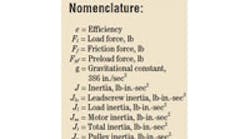The basics of motion control: Part 1
The first step in determining the requirements of a motion-control system is to analyze the mechanics — including friction and inertia — of the load to be positioned. Load friction can easily be determined either by estimating or by simply measuring with a torque wrench.
Inertia — the resistance of an object to accelerate or decelerate — defines the torque required to accelerate a load from one speed to another, but it excludes frictional forces. Inertia is calculated by analyzing the mechanical linkage system that is to be moved. Such systems are categorized as one of four basic drive designs: direct, gear, tangential, or leadscrew.
In the following analyses of mechanical linkage systems, the equations reflect the load parameters back to the motor shaft. A determination of what the motor “sees” is necessary for selecting both motor and control.
Cylinder inertia
The inertia of a cylinder can be calculated based on its weight and radius, or its density, radius, and length.
Solid cylinder, Figure 1.
Based on weight and radius:
Based on density, radius, and length:
Hollow cylinder, Figure 2. Based on weight and radius:
Based on density, radius, and length:
With these equations, the inertia of mechanical components (such as shafts, gears, drive rollers) can be calculated. Then, the load inertia and friction are reflected through the mechanical linkage system to determine motor requirements.
Example: If a cylinder is a leadscrew with a radius of 0.312 in. and a length of 22 in., the inertia can be calculated by using Table 1 and substituting in equation 2:
Direct drive
The simplest drive system is a direct drive, Figure 3. Because there are no mechanical linkages involved the load parameters are directly transmitted to the motor. The speed of the motor is the same as that of the load, so the load friction is the friction the motor must overcome, and load inertia is what the motor “sees.” Therefore, the total inertia is the load inertia plus the motor inertia.
Gear drive
The mechanical linkage between the load and motor in a gear drive, Figure 4, requires reflecting the load parameters back to the motor shaft. As with any speed changing system, the load inertia reflected back to the motor is a squared function of the speed ratio.
Continue on page 2
Motor speed:
Example: To calculate the reflected inertia for a 6-lb, solid cylinder with a 4- in. diameter, connected through a 3:1 gear set, first use equation 1 to determine the load inertia.
To reflect this inertia through the gear set to the motor, substitute in equation 9.
For high accuracy, the inertia of the gears should be included when determining total inertia. This value can be obtained from literature or calculated using the equations for the inertia of a cylinder. Gearing efficiencies should also be considered when calculating required torque values.
Tangential drive
Consisting of a timing belt and pulley, chain and sprocket, or rack and pinion, a tangential drive, Figure 5, also requires reflecting load parameters back to the motor shaft.
Motor speed:
Example: A belt and pulley arrangement will be moving a weight of 10 lb. The pulleys are hollow cylinders, 5-lb each, with an outer radius of 2.5 in. and an inner radius of 2.3 in.
Continue on page 3
To calculate the inertial for a hollow, cylindrical pulley, substitute in equation 3:
Substitute in equation 14 to determine load inertia:
Total inertia reflected to the motor shaft is the sum of the two pulley inertias plus the load inertia:
Also, the inertia of pulleys, sprockets or pinion gears must be included to determine the total inertia.
Leadscrew drive
Illustrated in Figure 6, a leadscrew drive also requires reflecting the load parameters back to the motor. Both the leadscrew and the load inertia have to be considered. If a leadscrew inertia is not readily available, the equation for a cylinder may be used.
For precision positioning, the leadscrew may be preloaded to eliminate or reduce backlash. Such preload torque can be significant and must be included, as must leadscrew efficiency.
Motor speed:
Friction force:
Example: A 200-lb load is positioned by a 44-in. long leadscrew with a 0.5-in. radius and a 5-rev/in. pitch. The reflected load inertia is:
Leadscrew inertia is based on the equation for inertia of a cylinder:
Total inertia to be connected to the motor shaft is:
The next article will show you how to how to use this information to determine torque and power requirements for selecting motor and control.
